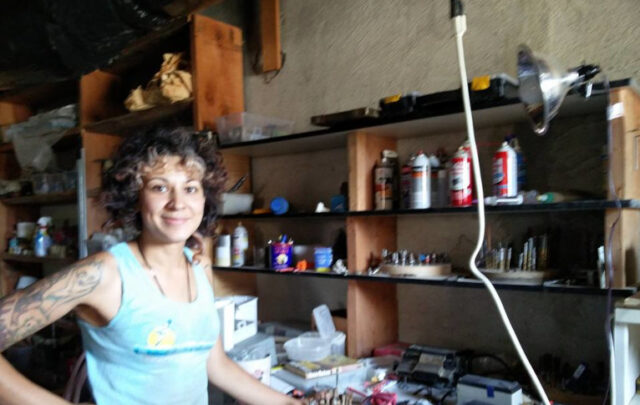As a writer on environmental topics, I try to limit my purchase of consumer products whenever possible. I do, however, permit myself a couple of extravagances. One is books: my job requires me to be conversant with the latest thinking in my field, so I’ve accumulated hundreds of volumes on climate change, ecological economics, anthropology, and environmental history. My other vice consists of a modest collection of antique Parker and Sheaffer fountain pens made between the years 1924 and 1960. These pens give me daily pleasure as I fill, use, and reuse one after another to write notes, outlines, and lists or to practice a little italic calligraphy. I justify this self-indulgence with the excuse that it doesn’t entail much new resource extraction or energy expenditure. Further, learning about fountain pens has provided some useful insights into American economic and social trends during the last century.
The fountain pen is an ingenious handwriting tool developed in the late 19th and early 20th centuries. While good pens were made in Britain, Germany, Japan, and other countries, most of the key technical advances occurred in the hinterlands of the United States.
George S. Parker started the Parker Pen Company in 1892; Walter A. Sheaffer filed his first patent in 1908 and an application for incorporation in 1913. Both men had been small-town jewelers. Both their organizations initially consisted of a workshop with a handful of skilled employees. And both companies were headquartered in the Midwest—Parker in Janesville, Wisconsin and Sheaffer in Fort Madison, Iowa (where I lived as a young boy). These companies eventually grew to employ thousands of locals; they were the economic engines of their regions.
The beautifully colored pens of the 1930s and early ’40s were constructed of brass, gold, and celluloid—an early plastic made of plant-based material treated with various chemicals, adopted first by Sheaffer in 1924. Manufacturers competed to devise new ink filling mechanisms (levers, buttons, vacuum pumps, and plungers) and to enliven their products with pleasing and sometimes futuristic Art Deco shapes. The best makers offered lifetime guarantees.
The functional development of the American fountain pen achieved its zenith around 1950. By then, Parker had introduced its revolutionary “51” model, whose streamlined barrel was milled from durable Lucite, its cap and trademark arrow-shaped clip fashioned from stainless steel. Its hooded nib kept the pen from leaking ink onto fingers or clothing, and it never skipped. These pens are nearly indestructible. Millions of Parker “51s” were manufactured (and later, hundreds of millions of cheap Chinese knock-offs), and, if you are lucky enough to find one in a junk shop, it will likely require no expensive restoration in order to work as well as it did when it was new—merely an overnight soak in tap water.
During the 1950s, Sheaffer was producing “Snorkels”—pens that fill by turning a knob at the back of the barrel, thereby extending a tube from the nib at the front; a vacuum pump then draws up ink from a bottle. This was the most complicated filling mechanism ever invented—but one that’s also reliable and fun to use once it’s restored. Again, millions were produced in a wide range of colors and grades of trim. Even the cheapest “Snorkel” is a superbly engineered writing instrument.
By the late ’50s, nearly all pen bodies were being manufactured using injection-molded plastics made from hydrocarbons. Molding parts rather than milling them from solid rods of celluloid or Lucite reduced the need for skilled handwork, thereby lowering costs. But gone were the gorgeous mottled and patterned celluloids that had lit up desks, purses, and suit jackets during the otherwise drab Depression.
Fountain pen manufacturing was big business in the first half of the 20th century because nearly everyone did a lot of handwriting. Millions of letters were written to and from troops during the two World Wars, and between family members as they traveled to pursue jobs in distant cities. Billions of written words flowed from the gold nibs of fountain pens (typewriters were for office work). Writing was a personal, tactile, and expressive process, and third-graders spent many tedious hours mastering the Palmer Method of legible, efficient penmanship.
The decline of the American fountain pen began with the advent of the ballpoint in the ’50s. This was a cheaper, more convenient, and often disposable alternative. But nearly everyone’s handwriting went to hell: a ballpoint pen simply can’t be controlled as well as a good dip or reservoir pen (though left-handed writers sometimes disagree). The pen industry’s downturn worsened in the 1980s and ’90s with the appearance of desktop and laptop personal computers, and steepened to a nosedive in the 2000s with the widespread adoption of hand-held computing devices. Today’s third-graders no longer study penmanship. As a result, few children can even decipher (much less reproduce) the cursive “antique writing” that their grandparents painstakingly practiced.
When fountain pen manufacturers fell on hard times in the 1960s, workers started getting laid off. Disposable plastic ink cartridges replaced the many methods of filling fountain pens from glass ink bottles. Parker and Sheaffer were bought by big multinational corporations, and they increasingly produced ballpoints (though both companies also eventually introduced expensive flagship fountain pen models aimed at collectors and fussy executives). Today the factories in Janesville and Fort Madison are shuttered, and current lines of Parker and Sheaffer pens are made overseas.
Something similar happened in dozens of other industries. Markets changed; skilled jobs dried up; and the production of many consumer products shifted from the US to Japan, China, and other countries. Throughout the past five decades, large numbers of talented and ambitious young Midwesterners migrated to the coasts. Their vast, once-thriving region came to be known as the Rust Belt or Fly-Over Country.
The early 20th century was no Eden: while it was a time of industrialization, productivity, and increasing prosperity for many, these trends were enabled by the rapidly increasing and unsustainable use of fossil fuels, the exploitation of poor people across the world for cheap labor, and the intensive looting of the natural environment. The World Wars and the Depression hardly felt like paradise at the time. Nevertheless, compared to what would come later, this period would offer some folks plenty of fodder for nostalgia.
In 2016 and again in 2020, “Make America Great Again” signs popped up on lawns across Wisconsin and Iowa—former hotbeds of farm-based progressive populism. The sentiment is understandable. Of course, the revival of the fountain pen industry was never part of the Trump agenda; Republicans merely directed Midwesterners’ simmering frustration toward immigrants and coastal elites. These politicians’ promises to revive the coal industry came to nothing—thankfully, from an environmental point of view—and their calls to repatriate manufacturing have likewise mostly gone unanswered. Deindustrialization and the brain drain contributed to political polarization and dysfunction, as the overall economic trajectory of the US was inexorably driven by ongoing processes of fossil fuel depletion, financialization, and globalization. Today, the country is widely viewed as an empire in steep decline, perhaps approaching collapse.
Fountain pen collecting has itself changed: when I started buying pens in the 1980s, new acquisitions came from antique or junk stores. A high-quality Parker or Sheaffer in excellent condition might turn up on an annual or semi-annual basis; and, if I was lucky, it would cost just a few dollars. I learned to do simple repairs by trial and error or by talking to other, more knowledgeable collectors. Today, the vintage pen market has migrated to eBay and regional pen shows. Online, you’re bidding against collectors scattered around the world; prices settle at predictable levels for condition and rarity. It’s easier to assemble a collection, but it’s more expensive and often not as much fun. YouTube videos teach enthusiasts how to change an ink sac, adjust a nib, or repair a filler.
Fountain pen collecting is a subject of almost no consequence compared to topics I usually write about—climate change, resource depletion, and economic inequality. But it does offer another, perhaps less obviously worrisome and more entertaining, way of understanding the times we inhabit. And it’s an activity that may have handy repercussions one day if the grid goes down and we still need to communicate.
Teaser photo credit: Parker “Duofold,” 1932, from the author’s collection






